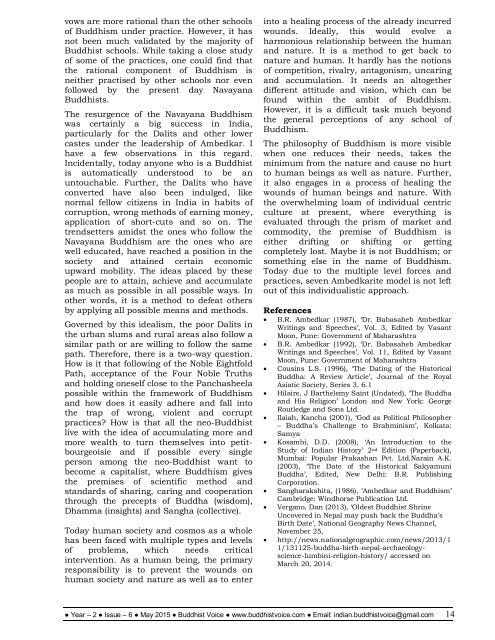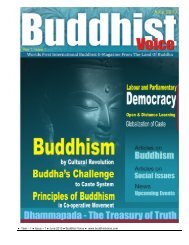BV - May 2015 Yr 2 Issue 6 E
You also want an ePaper? Increase the reach of your titles
YUMPU automatically turns print PDFs into web optimized ePapers that Google loves.
vows are more rational than the other schools<br />
of Buddhism under practice. However, it has<br />
not been much validated by the majority of<br />
Buddhist schools. While taking a close study<br />
of some of the practices, one could find that<br />
the rational component of Buddhism is<br />
neither practised by other schools nor even<br />
followed by the present day Navayana<br />
Buddhists.<br />
The resurgence of the Navayana Buddhism<br />
was certainly a big success in India,<br />
particularly for the Dalits and other lower<br />
castes under the leadership of Ambedkar. I<br />
have a few observations in this regard.<br />
Incidentally, today anyone who is a Buddhist<br />
is automatically understood to be an<br />
untouchable. Further, the Dalits who have<br />
converted have also been indulged, like<br />
normal fellow citizens in India in habits of<br />
corruption, wrong methods of earning money,<br />
application of short-cuts and so on. The<br />
trendsetters amidst the ones who follow the<br />
Navayana Buddhism are the ones who are<br />
well educated, have reached a position in the<br />
society and attained certain economic<br />
upward mobility. The ideas placed by these<br />
people are to attain, achieve and accumulate<br />
as much as possible in all possible ways. In<br />
other words, it is a method to defeat others<br />
by applying all possible means and methods.<br />
Governed by this idealism, the poor Dalits in<br />
the urban slums and rural areas also follow a<br />
similar path or are willing to follow the same<br />
path. Therefore, there is a two-way question.<br />
How is it that following of the Noble Eightfold<br />
Path, acceptance of the Four Noble Truths<br />
and holding oneself close to the Panchasheela<br />
possible within the framework of Buddhism<br />
and how does it easily adhere and fall into<br />
the trap of wrong, violent and corrupt<br />
practices? How is that all the neo-Buddhist<br />
live with the idea of accumulating more and<br />
more wealth to turn themselves into petitbourgeoisie<br />
and if possible every single<br />
person among the neo-Buddhist want to<br />
become a capitalist, where Buddhism gives<br />
the premises of scientific method and<br />
standards of sharing, caring and cooperation<br />
through the precepts of Buddha (wisdom),<br />
Dhamma (insights) and Sangha (collective).<br />
Today human society and cosmos as a whole<br />
has been faced with multiple types and levels<br />
of problems, which needs critical<br />
intervention. As a human being, the primary<br />
responsibility is to prevent the wounds on<br />
human society and nature as well as to enter<br />
into a healing process of the already incurred<br />
wounds. Ideally, this would evolve a<br />
harmonious relationship between the human<br />
and nature. It is a method to get back to<br />
nature and human. It hardly has the notions<br />
of competition, rivalry, antagonism, uncaring<br />
and accumulation. It needs an altogether<br />
different attitude and vision, which can be<br />
found within the ambit of Buddhism.<br />
However, it is a difficult task much beyond<br />
the general perceptions of any school of<br />
Buddhism.<br />
The philosophy of Buddhism is more visible<br />
when one reduces their needs, takes the<br />
minimum from the nature and cause no hurt<br />
to human beings as well as nature. Further,<br />
it also engages in a process of healing the<br />
wounds of human beings and nature. With<br />
the overwhelming loam of individual centric<br />
culture at present, where everything is<br />
evaluated through the prism of market and<br />
commodity, the premise of Buddhism is<br />
either drifting or shifting or getting<br />
completely lost. <strong>May</strong>be it is not Buddhism; or<br />
something else in the name of Buddhism.<br />
Today due to the multiple level forces and<br />
practices, seven Ambedkarite model is not left<br />
out of this individualistic approach.<br />
References<br />
B.R. Ambedkar (1987), ‘Dr. Babasaheb Ambedkar<br />
Writings and Speeches’, Vol. 3, Edited by Vasant<br />
Moon, Pune: Government of Maharashtra<br />
B.R. Ambedkar (1992), ‘Dr. Babasaheb Ambedkar<br />
Writings and Speeches’, Vol. 11, Edited by Vasant<br />
Moon, Pune: Government of Maharashtra<br />
Cousins L.S. (1996), ‘The Dating of the Historical<br />
Buddha: A Review Article’, Journal of the Royal<br />
Asiatic Society, Series 3, 6.1<br />
Hilaire, J Barthelemy Saint (Undated), ‘The Buddha<br />
and His Religion’ London and New York: George<br />
Routledge and Sons Ltd.<br />
Ilaiah, Kancha (2001), ‘God as Political Philosopher<br />
– Buddha’s Challenge to Brahminism’, Kolkata:<br />
Samya<br />
Kosambi, D.D. (2008), ‘An Introduction to the<br />
Study of Indian History’ 2 nd Edition (Paperback),<br />
Mumbai: Popular Prakashan Pvt. Ltd.Narain A.K.<br />
(2003), ‘The Date of the Historical Sakyamuni<br />
Buddha’, Edited, New Delhi: B.R. Publishing<br />
Corporation.<br />
Sangharakshita, (1986), ‘Ambedkar and Buddhism’<br />
Cambridge: Windhorse Publication Ltd.<br />
Vergano, Dan (2013), ‘Oldest Buddhist Shrine<br />
Uncovered in Nepal may push back the Buddha’s<br />
Birth Date’, National Geography News Channel,<br />
November 25,<br />
http://news.nationalgeographic.com/news/2013/1<br />
1/131125-buddha-birth-nepal-archaeologyscience-lumbini-religion-history/<br />
accessed on<br />
March 20, 2014.<br />
● Year – 2 ● <strong>Issue</strong> – 6 ● <strong>May</strong> <strong>2015</strong> ● Buddhist Voice ● www.buddhistvoice.com ● Email: indian.buddhistvoice@gmail.com 14



